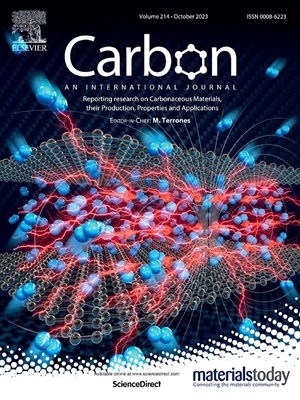Controlling water clusters under confinement in a graphene oxide matrix
IF 10.5
2区 材料科学
Q1 CHEMISTRY, PHYSICAL
引用次数: 0
Abstract
Porous materials hold water in two forms: surface-bound water and clustered water. The pore size and wall chemistry are important in determining the water clustering. Graphene oxide (GO) is unique because its dynamic pores, in the form of sub-nanometer interlayer spaces, can expand upon water intercalation. In this work, we investigate the water-cluster formation using temperature-dependent water sorption isotherms complemented with chemical analysis. We have demonstrated that the size of water clusters is largely independent of the oxidative state of the wall surfaces, for C: O ratio . However, crosslinking the GO sheets with an amine binder severely quenches the water clustering even though the primary sites are well populated. The critical cluster size around an adsorbed water molecule diminishes from to 0.1 for the crosslinked system. We attribute this effect to a restricted expansion of the spacing between the graphene oxide sheets and a dense network of linkages in the space between the sheets.

在氧化石墨烯基体中控制水团簇
多孔材料以两种形式保存水:表面结合水和聚集水。孔隙大小和壁化学性质是决定水聚类的重要因素。氧化石墨烯(GO)是独特的,因为它的动态孔隙,以亚纳米形式的层间空间,可以在水插入时扩大。在这项工作中,我们利用温度依赖的水吸附等温线和化学分析来研究水团簇的形成。我们已经证明,水簇的大小在很大程度上与壁面的氧化状态无关,因为C: O比≈2.5−5.1。然而,用胺粘合剂将氧化石墨烯片交联严重地抑制了水的聚集,即使主位点很密集。对于交联体系,吸附水分子周围的临界簇大小从≈1.6减小到0.1。我们将这种效应归因于氧化石墨烯片间距的有限扩展以及片间空间中的密集连接网络。
本文章由计算机程序翻译,如有差异,请以英文原文为准。
求助全文
约1分钟内获得全文
求助全文
来源期刊

Carbon
工程技术-材料科学:综合
CiteScore
20.80
自引率
7.30%
发文量
0
审稿时长
23 days
期刊介绍:
The journal Carbon is an international multidisciplinary forum for communicating scientific advances in the field of carbon materials. It reports new findings related to the formation, structure, properties, behaviors, and technological applications of carbons. Carbons are a broad class of ordered or disordered solid phases composed primarily of elemental carbon, including but not limited to carbon black, carbon fibers and filaments, carbon nanotubes, diamond and diamond-like carbon, fullerenes, glassy carbon, graphite, graphene, graphene-oxide, porous carbons, pyrolytic carbon, and other sp2 and non-sp2 hybridized carbon systems. Carbon is the companion title to the open access journal Carbon Trends. Relevant application areas for carbon materials include biology and medicine, catalysis, electronic, optoelectronic, spintronic, high-frequency, and photonic devices, energy storage and conversion systems, environmental applications and water treatment, smart materials and systems, and structural and thermal applications.
 求助内容:
求助内容: 应助结果提醒方式:
应助结果提醒方式:


